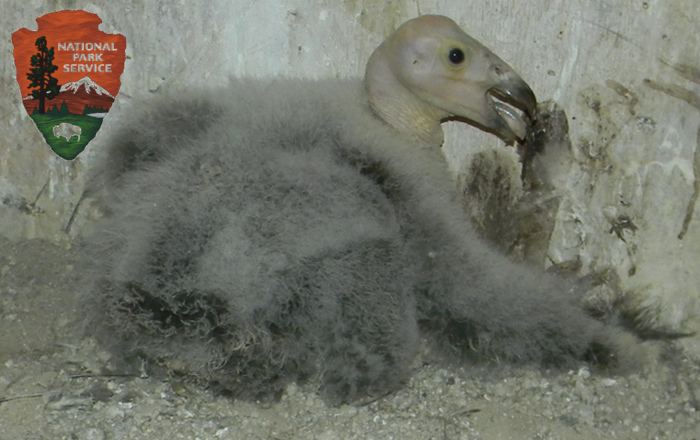The discovery of a pair of California condors raising a chick in Utah marks the first verified hatching of California condors in Utah since being reintroduced to the area in 1996.
For weeks, biologists from several agencies and groups focused their attention on a rock cavity in Zion National Park. The cavity is 1,000 feet above a remote canyon floor. Inside the cavity, biologists were hoping a pair of California condors had hatched an egg. Their hopes were realized on June 25, when a condor chick made its first appearance on the edge of the nest. This chick is the offspring of first-time nesting parents. The occasion is particularly momentous, because the results of first-time nesters often fail.
“This is the first documented occurrence of California condors raising a chick in Utah,” said Eddie Feltes, condor project manager with The Peregrine Fund. “This is great news. This pair of condors — and their newly hatched chick — could be a major step toward California condors re-establishing themselves in Southern Utah.”
Keith Day, regional wildlife biologist for the Utah Division of Wildlife Resources, said the chick won’t try to fly until November or December. “California condors take about six months to fledge,” he said. “Their fledging period is the longest of any bird in North America.” Day said the parents will spend the next year raising the chick. “California condors typically produce one chick every other year,” he said, “so they probably won’t nest again until the early months of 2016.”
How biologists found the nest
The Peregrine Fund biologists found the nest by following radio and GPS signals from transmitters mounted on each of the chick’s parents. They started keeping a close eye on the birds after the pair exhibited nesting behavior this spring.
Biologists and the condor recovery program’s partner agencies were excited when the birds started displaying behavior that indicated they were incubating an egg. The excitement grew even more when the pair showed signs they were tending a chick.
“It was only a matter of time before the birds started nesting in Utah,” said Chris Parish, condor field project supervisor with The Peregrine Fund. “There is great habitat in Utah. It didn’t take long for the condors to find it.”
Working cooperatively with the U.S. Fish and Wildlife Service, the Utah DWR, the Arizona Game and Fish Department, the Bureau of Land Management, the U.S. Forest Service, and the National Park Service, The Peregrine Fund has taken the lead on reintroducing and restoring this federally endangered species in northern Arizona and Southern Utah.




